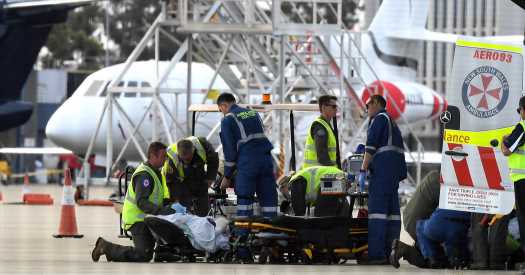New Zealand Seeks Human Skin to Treat Volcano Burn Victims

To treat more than two dozen tourists severely burned in a volcanic explosion earlier this week, doctors in New Zealand are rushing to obtain a unique medical export from the United States.
The doctors are buying nearly 1,300 square feet of human skin.
At a briefing on Thursday in Auckland, health officials outlined the desperate task before them. The volcanic explosion on White Island left 27 visitors with severe burns, some covering up to 95 percent of their bodies. Twenty-two are in critical condition.
Surgeons already have been operating nonstop on these patients, because many of the injuries were worsened by chemicals and gases in the eruption. But there is not enough human skin in New Zealand for surgeons to treat all of the injuries they are seeing.
“The health system is equipped to respond to this, but in terms of the size, these are very unusual events,” said Dr. John Kenealy, clinical director of surgery at Counties Manukau in New Zealand. “The number of burns is unprecedented.”
While organs like hearts and livers are routinely donated after death, the procurement of skin is less well known — and more loosely regulated. The United States is a leading producer, and the enterprise is a vast one built largely on the altruism of deceased organ donors.
There are 158 tissue banks in the United States accredited by the American Association of Tissue Banks, but there are hundreds not affiliated with the association. The accredited facilities recover skin from 39,000 donors a year, which is used to make 3.2 million grafts.
[Like the Science Times page on Facebook. | Sign up for the Science Times newsletter.]
Human skin is removed from deceased donors by procurers that also harvest other organs. A single body can provide up to 5,000 square inches of transplantable skin, according to the American Association of Tissue Banks.
Skin is much easier to obtain than a heart or cornea. Organs like these can be retrieved only under limited conditions, while skin can be recovered up to 24 hours after the donor has died.
Donors are screened for infectious diseases, and there is no age limit for donation; although the elderly tend to have thinner skin, theirs can be donated as well, because surgeons use the grafts only temporarily.
The procedure is performed in a sterile room, with an instrument described as a cross between a cheese slicer and an electric razor. It is the same device that surgeons use to take skin from one part of a patient’s body to graft elsewhere.
Skin procurement for tissue banks is not done by surgeons, however, but by trained technicians with no formal medical education who learn on the job.
In some cases, only a thin layer of skin — consisting of the thin top layer of dead skin cells, called the epidermis, and part of the dermis, the second layer, containing hair follicles and glands — is harvested, in strips four to six inches wide and 12 one-thousandths of an inch thick.
No muscle or internal structures are exposed when the procedure is done this way, and an open-casket funeral can still be possible, because the skin is often removed from large, flat areas that will be covered by clothing, like the back and buttocks.
“You do not see the underlying structures or muscles, you’re just looking at deeper layer of the dermis of the skin,” said Dr. Shahriar Shahrokhi, a surgeon at the University of Toronto.
Some procurers, however, may take deeper cuts of skin that are more disfiguring, and may expose muscles, fascia and other structures. They may later separate the skin into a thin layer for grafts for burn victims, and a layer of dermis to be used in procedures like breast reconstruction after mastectomy.
Since there are usually no recipients waiting for skin, as there may be for organs like kidneys, the sheets are usually wrapped in gauze, folded, packaged individually, labeled and frozen. Donated skin can be kept this way up to five years.
The frozen sheets are thawed in a warm bath of saline before use on a patient, when they are stapled, sutured or glued on, Dr. Shahrokhi said.
To treat a burn patient, the surgeon removes dead skin as soon as the patient is stabilized, in order to prevent life-threatening infections like sepsis.
But the donor skin graft that is applied is only a temporary patch; it will be rejected by the patient’s immune system within a matter of weeks. Still, it provides the protective function of healthy skin: closing the wound, protecting against infections and fluid loss, decreasing pain and promoting healing.
Ultimately, the donor skin, called an allograft, must be replaced with an autograft, skin taken from another part of the patient’s own body.
Human skin is expensive. A single square centimeter can cost a hospital about $2.82, depending on the source, according to Mag Tait, director of the Trauma Burn Laboratory at Michigan Medicine.
The skin ordered by New Zealand could cost millions of dollars, unless organizations elect to donate it. The patients will need repeated surgeries over months, according to health officials.
“For many of us, it feels surreal,” said David van Dijk, a coordinator at Whakatane Hospital, where many of the burn patients were taken. “Many of us are still coming to terms with what happened.”
Jamie Tarabay contributed reporting from Whakatane, New Zealand.
Source: Read Full Article